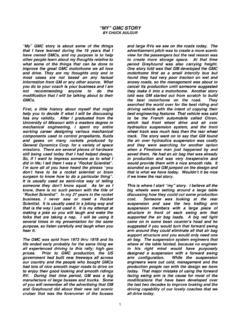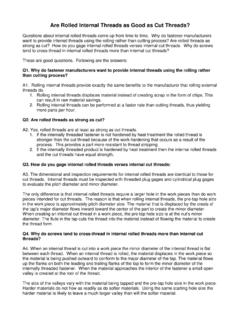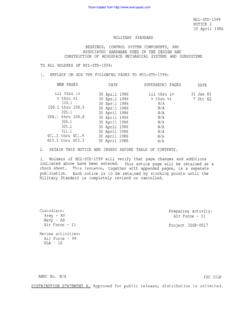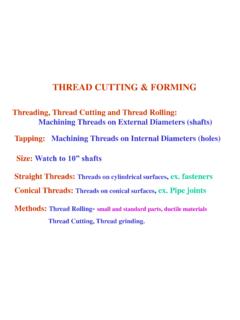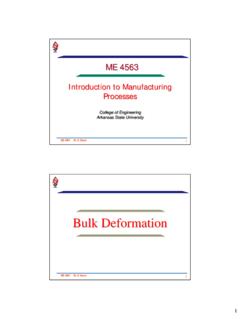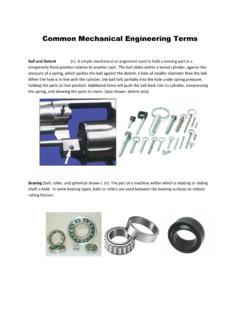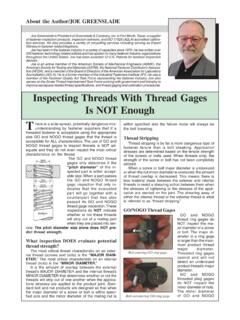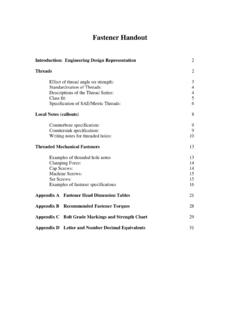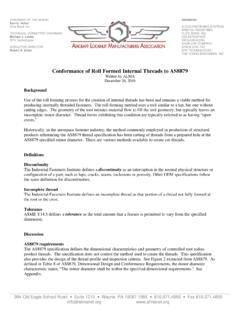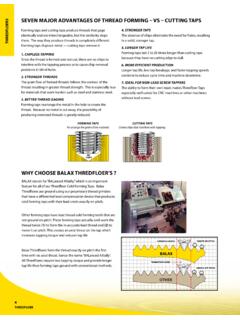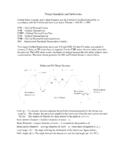Transcription of KEEPING IT TOGETHER - GMC motorhome
1 KEEPING IT TOGETHER THE NUTS AND BOLTS OF FASTENERS Presented by Jim Rowe October 2011 We take fasteners and the complex system we have for identifying them by type and usage for granted. Here is some information that may help you in choosing the proper fastener for all your repair/replacement needs. 2 Starting at the beginning, the invention of the screw thread is attributed to Archimedes in the 3rd century BC. The Archimedes Screw consisted of a cylinder with an internal continuous screw thread . When the lower end was placed into water and the cylinder rotated, water was raised to a higher level.
2 The principle was also applied for handling light, loose materials such as grain, sand and ashes. The screws that we have today use the same technique in that a mating threaded component, rather than water, is moved through the cylinder. Sir Joseph Whitworth, a British mechanical engineer, became known for his work on engineering standards. In 1841 he proposed the introduction of standard fastener sizes to the Institution of Civil Engineers. These comprised a universal set of specifications for the angle and pitch of screw threads, the Whitworth thread became the first standard thread system in the world.
3 Threaded fasteners are classified by shape, material and finish, which are specified by industry standards. In the United States, the American Society for Testing Materials (ASTM) sets the standards. In Europe, the International Standards Organization (ISO) sets the standards. Types of Fasteners Unified National Coarse Threads (UNC) UNC threads are the most common general fastener thread . Their fit is deeper and more generic than that of a fine thread , allowing for easy removal. Generally, they have a higher tolerance for manufacturing and plating, and do not need cross threading to assemble.
4 Unified National Fine Threads (UNF) UNF threads have better torque-locking and load-carrying ability than UNC threads because of their larger minor diameter. Because of their more specific fit, they have tighter tolerances, finer tension adjustment, and can carry heavier loads. They are most commonly found in the aerospace industry. United National Extra Fine Threads (UNEF) UNEF threads are finer than UNF threads; they are used in applications with tapped holes in hard material, thin threaded walls, and tapped holes in thin material.
5 As with UNF threads, UNEF threads are common in the aerospace industry. UNJC and UNJF Threads There are two types of J threads: external and internal. external UNJC and UNJF threads have a larger root radius than the corresponding part (either UNC, UNR, UNK, or UNF threads). The larger root radius results in a larger tensile area than the corresponding thread , and smaller stress concentration bolts that carry heavy loads usually use J threads. UNR and UNK Threads A UNR external thread is the same as a UNC thread , only the root radius is rounded.
6 There is no internal UNR thread . UNK threads resemble UNR threads, but the root radius and minor diameter require inspection. Constant-Pitch Threads These threads come in a variety of diameters to fit a given application bolts with diameters of 1 in. and above commonly use pitches of 8, 12, or 16 threads per inch. CHARACTERISTICS OF BOLTS 3 How Strong is it? One important consideration in applying a bolt is its strength. The bolt material strength is determined by the alloy and processing method (for example, cold working and heat treating.)
7 The two important material properties are the tensile strength and yield strength. The tensile strength, sometimes called the ultimate strength, is the stress level where the material breaks. The yield strength is the stress level where the material yields or permanently deforms. When operating under any normal load fasteners should be below the yield stress. The tensile strength is always higher than the yield strength. Materials with a large difference between the yield and tensile strength are considered ductile, meaning they will stretch substantially before breaking.
8 The load a fastener carries is calculated by multiplying the material strength by the nominal cross-section area of the thread . For inch-size fasteners, the material strength is specified by the "grade." A grade 8 bolt is stronger than a grade 5, which is stronger than a grade 2. The grade is indicated by a series of marks on the bolt s head. For metric fasteners, the term "property class" is used and is stamped directly on the head. The property class for steel fasteners is given in the form , where X is 1/100 of the nominal tensile strength in newtons/mm2, and Y is 10 times the ratio between the yield strength and tensile strength.
9 The multiplication of these two numbers gives 1/10 of the yield strength in newtons/mm2 . For example, a fastener with a property class of has a nominal tensile strength of 800 newtons/mm2 (116,000 psi) and a yield strength of 640 newtons/mm2 (93,000 psi). Suppose that a metal specimen be placed in tension-compression-testing machine. As the axial load is gradually increased in increments, the total elongation over the gauge length is measured at each increment of the load and this is continued until failure of the specimen takes place.
10 Knowing the original cross-sectional area and length of the specimen, the normal stress and the strain can be obtained. The graph of these quantities with the stress along the y-axis and the strain along the x-axis is called the stress-strain diagram. The stress-strain diagram differs in form for various materials. The diagram shown below is that for a medium-carbon structural steel. 4 There are two common types of stainless steel fasteners: corrosion-resistant stainless steel, ASTM 304 ( 18-8) or DIN/ISO A2, and acid-resistant stainless steel, ASTM 316 or DIN/ISO A4.
